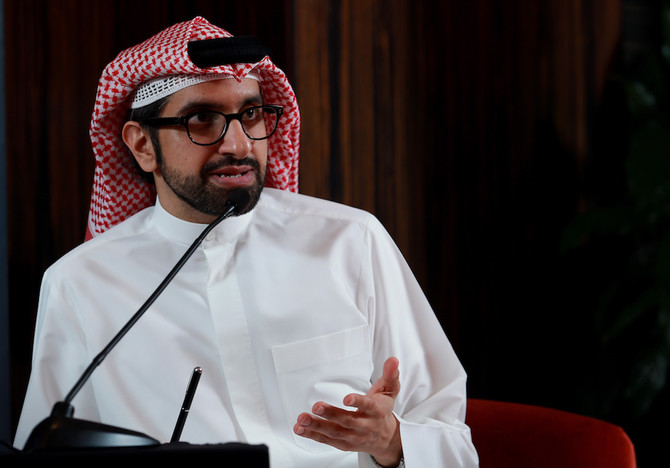LONDON: The scene is the High Court in London. On one side, Sheikh Sultan Al-Qassemi, founder of the Barjeel Art Foundation in the UAE and one of the world’s foremost collectors of contemporary art.
On the other side, Sotheby’s, the auctioneers. At stake, potentially, is the reputation of one of the world’s top auction houses and the £725,000 ($989,221) paid for a sculpture that may or may not be quite as advertised.
That is the price Al-Qassemi paid for “Au Bord du Nil” (On the Banks of the Nile), a 119cm bronze statue of a woman carrying a water jug, by Mahmoud Mokhtar, the sculptor widely considered to be the father of modern Egyptian sculpture and certainly among the greats of Middle Eastern art.
According to Sotheby’s catalogue for the sale, which took place on April 21, 2016, the piece was circa 1920s 1920s]. The buyer — in this case, Charles Pocock, adviser to Al-Qassemi and buyer for the Barjeel Art Foundation — requested a report from the foundry that cast the sculpture.
It arrived two months later, on June 21, 2016. “Within 24 hours, we knew we had a problem,” Pocock told Arab News.
The report from the Susse Foundry in Paris states that work on casting the sculpture began in August 1938 and it was released on to the market on March 14, 1939. But Mokhtar died in 1934, suggesting that the piece Al-Qassemi bought was a posthumous — and therefore unfinished — piece, meaning it was worth a good deal less than he paid.
The Susse Foundry made six castings and of those, only one was posthumous. But Sotheby’s strongly disagree that the foundry report should be interpreted as stating that the posthumous sculpture is the one bought by Al-Qassem.
However, because of certain marks on the statue, Al-Qassem and his team are convinced that he did indeed buy the posthumous casting. Again, Sotheby’s interpretation of the marks differs from Al-Qassem’s.
He obtained a new valuation of the sculpture of £70,000 - ten times less than what he paid and considerably less even than the £120,000-£180,000 Sotheby’s estimated it would fetch at auction.
Pocock said that when he contacted Sotheby’s, “In effect they verbally admitted to miscataloguing and offered to change the invoice.”
But further research revealed that none of the six castings of “Au Bord du Nil” done by Susse Foundry were from the 1920s.
The earliest was 1931. Previous sales at auction of other, smaller castings of the sculpture (including one sold by Sotheby’s in 2007) dated the piece from the 1930s. Al-Qassemi asked for his money back.
“And that’s when Sotheby’s threw legal at us,” Pocock said. “Suddenly, my communications were being handled by their lawyers so we had to go legal too.”
The court case opened in April last year and soon threw up another problem. Sotheby’s had to disclose that the consignor [seller] of the sculpture was Nesreen Farag, an art dealer based in New York and Marbella — and mother of Mai Eldib, Sotheby’s modern Arab art specialist and consultant for the sale of the Mokhtar sculpture.
This potentially created a conflict of interest. Sotheby’s own code of business conduct states that a conflict of interest can arise “when you or your immediate family members have a personal affiliation with a client, a client’s agent to competitor.”
The guide adds: “You must recognize that even the appearance of impropriety can be damaging to our reputation.”
Pocock said there had been “rumors” about Eldib and Farag. Yet he maintains that Eldib claimed not to know the seller of the Mokhtar sculpture. “Mai told me in May 2017 that she had never met the person consigning the artwork until they had consigned it in December, which I find quite hard to believe, considering it’s her mother,” he said.
He also remembers seeing her in the room during the sale, apparently taking telephone bids. “But who from?” he asked.
Sotheby’s confirm Eldib was on the phone “with an unrelated client (not her mother) and no bid was executed.”
The case is likely to end the long-standing and — until now — fruitful relationship between the great auction house and one if its top clients.
“Sheikh Sultan tried for a long time to settle this amicably. We have never disputed that the sculpture is by Mokhtar, but it was not completed in his lifetime, and that’s how it was sold. And it was the foundry report that Sotheby’s provided that alerted us to that,” Pocock said. “For the 25 percent premium —£125,000 in this case — that Sotheby’s gets, you expect them to do their research properly.
“Sheikh Sultan is feeling very aggrieved and disappointed. He doesn’t expect special treatment, but he doesn’t expect to be treated like this.”
In a statement Sotheby’s said the word “circa” was deliberately used in the catalogue for the sculpture and that the available information “strongly supports the view that this is lifetime cast.” The foundry report was a “hypothesis” which “does not state categorically that this sculpture was the one posthumous cast made in 1938 or 1939.”
The auction house said the identity of clients was confidential but there was no dispute about revealing the seller of the sculpture was Nesreen Farag.
The statement continued: “We never want a valued and respected client to be unhappy with our service, but in this case we simply could not resolve our good faith dispute, despite our very best efforts. We are confident that the court will find that Sotheby’s acted appropriately.”
The case in the High Court continues with Judge Waksman QC presiding. The sculpture remains in storage in London.

















